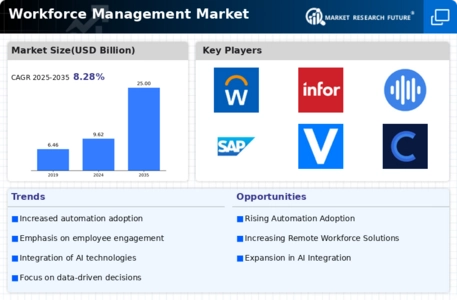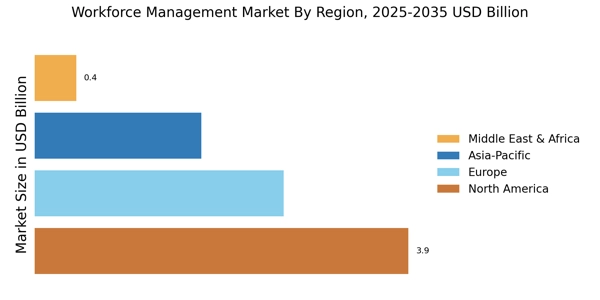Rising Demand for Operational Efficiency
The Workforce Management Market is experiencing a notable surge in demand for operational efficiency. Organizations are increasingly recognizing the need to optimize their workforce to enhance productivity and reduce costs. According to recent data, companies that implement effective workforce management solutions can achieve up to a 30% increase in productivity. This trend is driven by the necessity to streamline processes and improve resource allocation. As businesses strive to remain competitive, the focus on operational efficiency is likely to propel the growth of the Workforce Management Market. Furthermore, the integration of advanced analytics and reporting tools is enabling organizations to make data-driven decisions, thereby enhancing their operational capabilities.
Increased Focus on Compliance and Regulation
The Workforce Management Market is witnessing an increased focus on compliance and regulation. Organizations are under mounting pressure to adhere to labor laws and regulations, which necessitates robust workforce management solutions. The implementation of these solutions helps businesses avoid costly penalties and legal issues. Recent data suggests that companies investing in compliance-focused workforce management systems can reduce compliance-related costs by up to 25%. This trend is likely to drive the growth of the Workforce Management Market as organizations prioritize compliance to mitigate risks. Additionally, the integration of compliance features within workforce management software is becoming a standard expectation among businesses.
Emphasis on Employee Well-being and Engagement
The emphasis on employee well-being and engagement is becoming a critical driver in the Workforce Management Market. Organizations are increasingly recognizing the importance of fostering a positive work environment to enhance employee satisfaction and retention. Recent studies show that companies prioritizing employee engagement can experience a 20% increase in productivity. This focus on well-being is prompting businesses to invest in workforce management solutions that facilitate better communication, feedback, and support for employees. As the demand for such solutions grows, the Workforce Management Market is likely to expand, driven by the need to create a more engaged and motivated workforce.
Technological Advancements in Workforce Management
Technological advancements are playing a pivotal role in shaping the Workforce Management Market. The emergence of sophisticated software solutions, including predictive analytics and machine learning, is transforming how organizations manage their workforce. These technologies facilitate better forecasting of labor needs and enhance scheduling efficiency. Recent statistics indicate that companies utilizing advanced workforce management tools can reduce labor costs by approximately 20%. As organizations increasingly adopt these technologies, the Workforce Management Market is poised for substantial growth. The continuous evolution of technology not only improves operational efficiency but also enhances employee satisfaction by providing more flexible work arrangements.
Shift Towards Remote and Flexible Work Arrangements
The shift towards remote and flexible work arrangements is significantly influencing the Workforce Management Market. As organizations adapt to changing work environments, there is a growing need for effective management of remote teams. This trend has led to an increased demand for workforce management solutions that support remote monitoring, scheduling, and performance tracking. Recent surveys indicate that approximately 70% of companies are now utilizing workforce management tools to manage remote employees effectively. This shift is likely to continue driving the growth of the Workforce Management Market as businesses seek to maintain productivity and engagement in a flexible work landscape.


















Leave a Comment